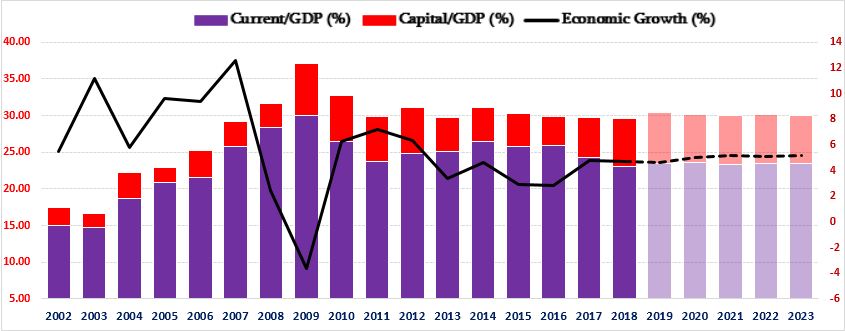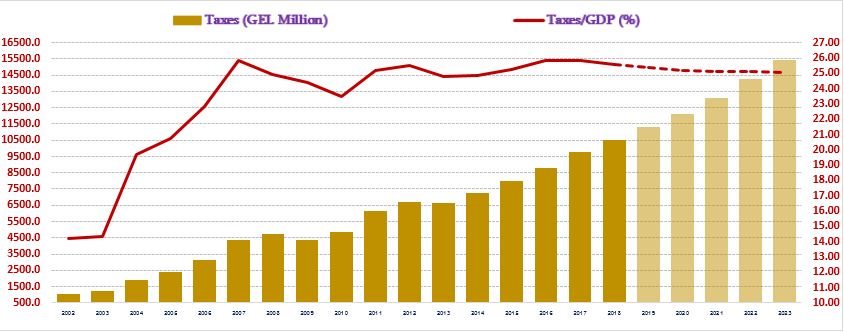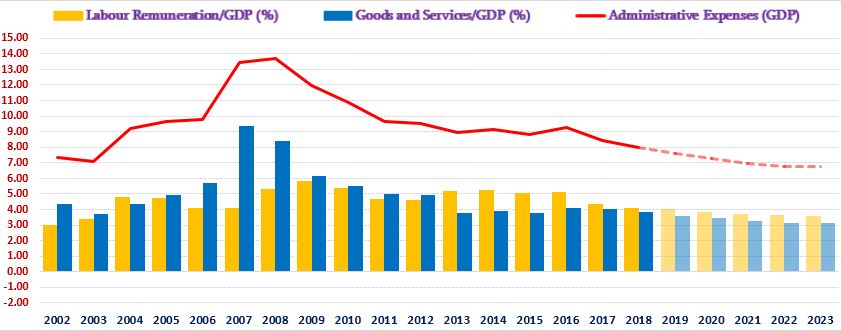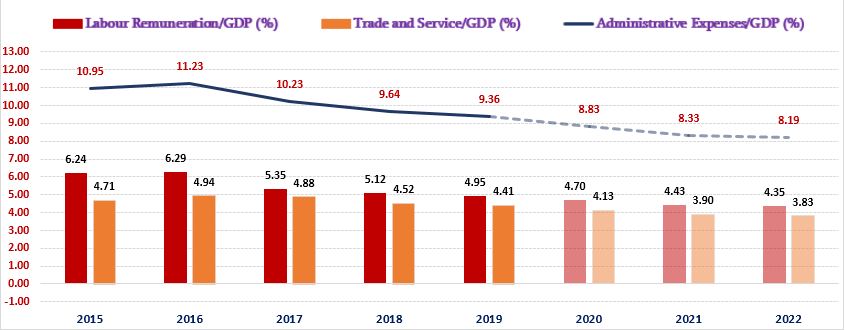Resume: It is impossible to offer a comprehensive analysis on the cause-effect relationship between the government’s size and economic growth as part of FactCheck’s article. However, as of the previous and the next years, the size of the government is not increasing. In the same period, the current expenses are characterised by a trend of decline whilst capital expenditures show a trend of growth. The latter is considered to be a positive factor for economic development. Apart from the government’s size, the tax burden is also not increasing.
In regard to administrative (bureaucratic) expenses, the ratio of labour remuneration as well as goods and services expenses to both the common and consolidated budgets are characterised by a clear-cut trend of decrease. These data include data from state administration units and encompass the central, autonomous and municipal levels. In addition, as per the 2018 law, the growth of labour remuneration (salary, bonus and salary supplement) was capped and a ceiling was imposed. This year, labour remuneration could have increased only in the case if the amount of the base nominal salary in the state budget had been changed. However, the base amount has not been changed and, therefore, the labour remuneration of public servants has also not increased. In 2018, the administrative expenses to the consolidated budget ratio was 9.64% which is a lower figure as compared to the previous years. In the same year, the administrative expenses to the common budget ratio was 7.96% which is also less as compared to the previous years. Of note is that an annual reduction of administrative expenses is planned for over the next five years.
Therefore, the statement about an increase in administrative (bureaucratic) expenses does not correspond to the truth because such types of expenses are characterised by a clear-cut trend of decrease.
Analysis
Chair of the European Georgia – Movement for Freedom Parliamentary Faction, Otar Kakhidze, on air on Rustavi 2, spoke about the government’s size and bureaucratic expenses. As stated by Mr Kakhidze: “It is an important factor that the economy is not growing and it does not grow precisely because of the large government burden. The bureaucratic expenses are increasing in a stable manner. These are government expenses as well as the expenses of different municipalities. You have transformed the public sector into a place of employment for your party activists who are not even satisfied with the salaries they receive and are getting more and more burdensome for our citizens.”
In his statement, the MP talks about the total government size and bureaucratic expenses, putting separate emphasis on the labour remuneration component and speaking about the growth of the salaries of public servants. In addition, Otar Kakhidze considers the growth in the government’s size to be a negative factor vis-à-vis economic growth which itself is a subject of normative discussion and, therefore, FactCheck will refrain from an analysis of this part. Of note is that the gross domestic product (GDP) consists of private consumption (C), government expenses (G), investments (I) and net export (NX). However, how the change in one GDP component influences the other and an assessment of this influence falls beyond FactCheck’s scope.
Graph 1: Common Budget’s Indicators and Economic Growth (%)

Source: Ministry of Finance, National Statistics Office of Georgia
As mentioned previously, FactCheck is unable to analyse how the size of a government affects economic growth as part of this article. However, of interest is to take a look at the trends of the aforementioned indicators and their changes. In 2018, payables in the common budget amounted to 29.57% of the GDP. Of that amount, the current expenses are 23.11% of the GDP whilst capital expenditures amount to 6.46%. Of note is that as compared to the previous years, the size of a government – payables to the common budget ratio – is characterised by a trend of decrease where current expenses decrease the most whilst capital expenditures increase. In regard to economic growth, Georgia’s economic growth was 4.7% in 2018 and 4.8% in the previous year. In the last five-year period, the government’s size was 30.12% on average whilst the annual economic growth rate stood at 4.0%.
Apart from the government’s size, within the context of the “government burden,” it is also interesting to take a look at the tax burden which is a principal source of funding for budget expenses. In turn, the tax burden reflects the resources which the government collects from the economy through taxation. Therefore, the tax burden is measured by the tax incomes to GDP ratio which also allows making an analysis within a timeframe. In 2018, tax income amounted to GEL 10,506.3 million which constitutes 25.58% of the GDP. In addition, the tax burden has been kept at an average of 25% in the last years and in accordance with the next five years forecast and without a clear-cut trend of change.
Graph 2: Tax Revenues (GEL Million, %)

Source: State Treasury, National Statistics Office of Georgia
The common budget incorporates the consolidated figures of the state, autonomous republic and self-governing unit budgets whilst the common budget’s administrative expenses are those expenses incurred for labour remuneration as well as for purchasing goods and services. In 2018, the administrative expenses to common budget ratio was 7.96% of the GDP. Of that amount, labour remuneration was 4.1% and goods and services was 3.86%. This year, administrative expenses in the common budget are planned at GEL 3,385 million which constitutes 7.62% of the GDP. Of that amount, GEL 1,785 (4.02% of the GDP) is allocated for labour remuneration and GEL 1,600 million (3.6% of the GDP) is allocated for purchasing goods and services. In turn, the administrative expenses to common budget ratio has been decreasing since 2017 in part related to the labour remuneration component as well.
Graph 3: Common Budget Administrative Expenses (%)

Source: Ministry of Finance, National Statistics Office of Georgia
The aforementioned indicators encompass the common budget which reflect the figures of spending institutions at the state, autonomous republic and municipal budget levels. However, the Ministry of Finance has started to draft a consolidated budget since 2019 which fully covers the state administration sector. These figures include both spending institutions and budgetary organisations at the central and local levels. In addition, the consolidated budget indicators show not only the administrative expenses from budget allocations but expenses covered by LEPLs and N(N)Les from their own incomes.
Graph 4: State Consolidated Budget Administrative Expenses (%)

Source: Ministry of Finance, National Statistics Office of Georgia
In 2018, the consolidated budget’s administrative expenses amounted to GEL 3,961 GEL. Of that amount, GEL 2,104 million was for labour remuneration whilst GEL 1,857 million was for goods and services. This constituted 9.64% of the GDP which is 0.59 of a percentage point less as compared to the previous year. In regard to this year, the consolidated budget’s administrative expenses are planned at GEL 4,158 million which constitutes 9.36% of the GDP. Of note is that the consolidated budget’s relative figures of labour remuneration and goods and services taken separately are characterised by a clear-cut trend of decrease in accordance with the previous year’s data and the forecast for the next four years.
The enactment of a new law on labour remuneration in the public sector since January 2018 brought legal clarity over the policy of labour remuneration for public servants, high-level officials and people with political positions. It also introduced a ceiling on cash labour remuneration – salary, bonus and salary supplement. The official salary is determined by multiplying the base nominal salary by a coefficient corresponding to the position in the public institution whilst the bonus or the salary supplement can be given within the margins of 30% of a total annual salary. However, high-level public officials and political figures are forbidden from receiving such kinds of rewards. Therefore, the growth of a public servant’s labour remuneration is capped and the only exception is when the base salary amount is increased in the state budget. In turn, in accordance with the Law on the 2018 State Budget, the base nominal salary was GEL 1,000 which was not changed in the 2019 budget and remains the same. Therefore, the labour remuneration of public servants as well as high-level public officials and political figures has not increased this year.








